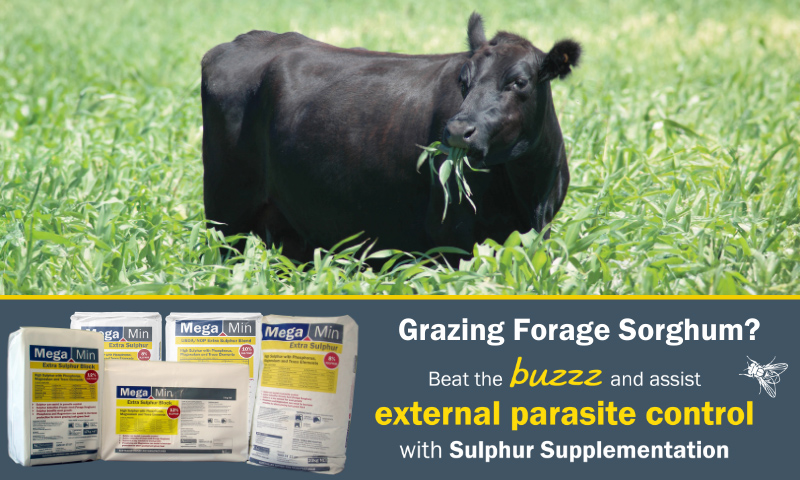At this time year, cattle are often impacted by external parasites such as buffalo fly, lice and ticks or may be grazing forage sorghum crops. In both of these scenarios, livestock have been shown to respond to sulphur supplementation.
Sulphur is an important component of some amino acids, vitamins and other essential nutrients and is crucial for maintaining livestock production. Before we look at the benefits of using sulphur supplements, let’s look at some of the functions of sulphur:
- The majority of sulphur occurs in proteins containing the amino acids, cystine, cysteine and methionine. Cystine and methionine are needed for the production of milk protein and wool, which contains about 4% protein, is high in cystine.
- Sulphur is an important detoxifier and helps the body to excrete chemical compounds such as prussic acid (hydrocyanic acid).
- Sulphur plays an important role in the synthesis of microbial protein.
- Sulphur also stimulates the manufacture of riboflavin and vitamin B12 in the rumen.
- Sulphur is involved in connective tissue, mainly chondroitin sulphate which is a component of cartilage, bone, tendons and the walls of blood vessels.
- Sulphur plays a role in carbohydrate, energy and fat metabolism.
- Sulphur-containing compounds are also important elements of the respiratory process.
What does sulphur deficiency look like in livestock?
Sulphur deficiency is closely related to protein deficiency, and can have detrimental effects on livestock production by:
- Reducing the rate of microbial synthesis,
- Reduced fibre digestion due to slower microbial growth in ruminants,
- Slow growth,
- Reduced feed efficiency,
- Reduced milk production,
- Reduced feed intake.
If the sulphur deficiency is not rectified and becomes severe, the following symptoms may be evident in stock:
- Unwillingness to eat,
- Weight loss,
- Ill-thrift, dullness and lethargy,
- Excessive salivation,
- Death.
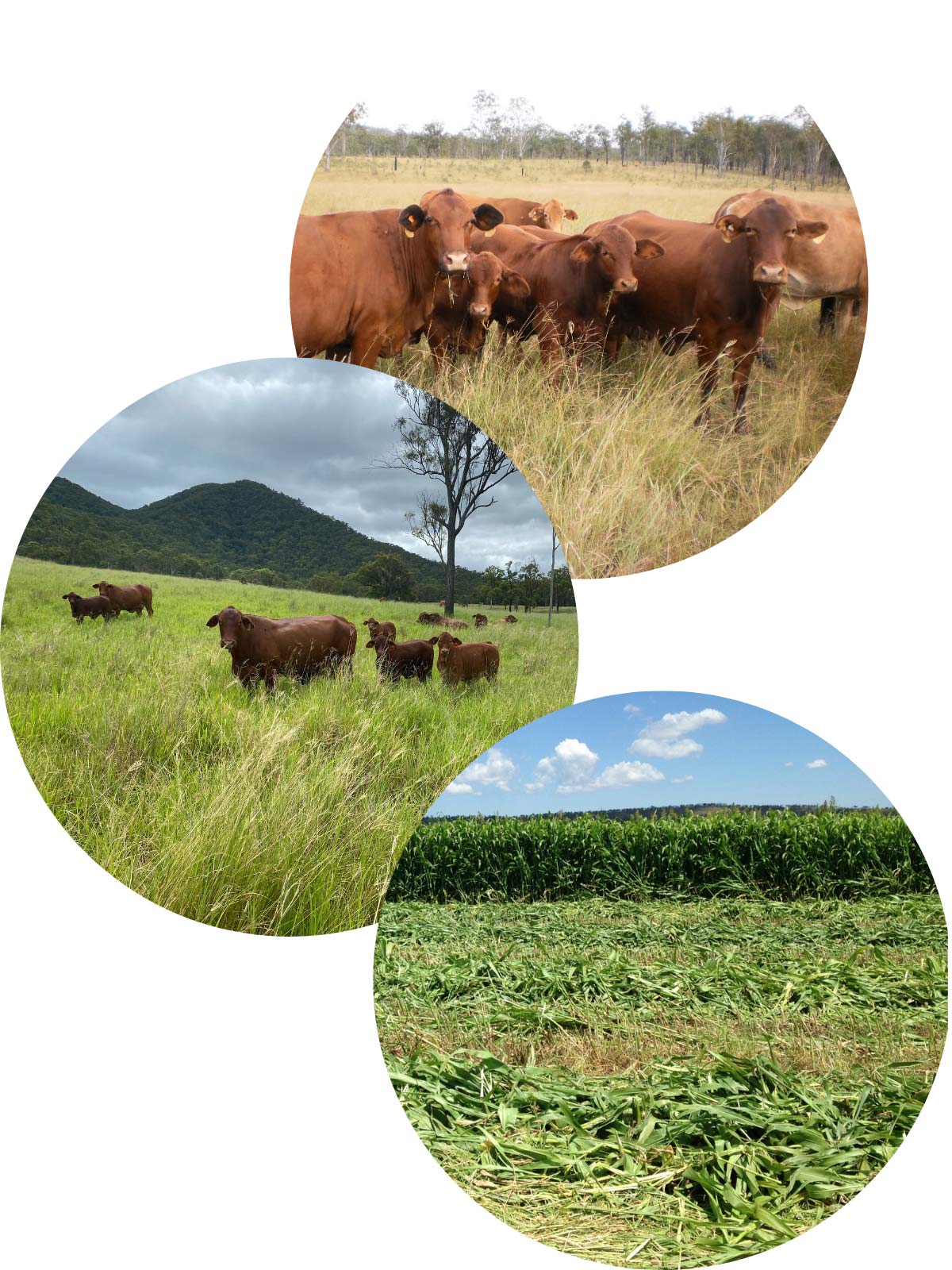
Sulphur supplementation provides production benefits in all seasons…
It is well known that additional sulphur is a key ingredient for dry feed supplements containing non-protein nitrogen sources such as urea. McDonald (2011) recognised that a lack of sulphur in the diet may be the limiting factor for the synthesis of cysteine, cystine and methionine in the rumen. These amino acids are crucial for optimum growth and nitrogen balance. Amino acid deficiency will impact protein synthesis and oftentimes will limit milk production and growth, negatively impact the immune system, reduce reproductive efficiency and subsequently reduce profits. The presence of sulphur in dry feed supplements is now expected in quality supplements.
During the better seasons when green pasture provides plenty of energy and protein, there is still significant production benefits to be gained by providing stock with access to supplementary minerals, particularly sulphur. Sulphur supplementation is also highly beneficial for stock grazing forage sorghum as well as sudan grasses or rapidly growing grasses and cereals grown in sandy or acid soil types.
A considerable amount research has shown that increased dietary sulphur can lead to increased meat, wool and milk production. As reported in Tisdale (1977), Dairy cattle with adequate amounts of sulphur had improved performance including higher production of milk solids, milk fat, milk protein and milk casein.
Hill (1984), found that supplementing sulphur deficient beef cattle improved average daily weight gains and increased carcass grading as well as decreasing feed costs per kg of weight gain. There are also reports of increased wool and meat production relative to an increase in the daily sulphur intake for sheep. Higher wool clips, improved wool strength, increased body weight gain and higher lamb survival rates were also reported in Tisdale, (1977).
The risks associated for livestock grazing forage sorghum
A number of plants (particularly sorghums and related species) can accumulate large quantities of prussic acid. These toxic compounds are found in the outer tissue of the plant and the enzymes that enable prussic acid production are located in the leaf tissue. Any event (such as chewing, trampling, chopping, drought, freezing, wilting etc) that ruptures the plant cells, allowing this compound to combine and enzymes to combine, contributes to the production of prussic acid.
When a plant containing high levels of prussic acid has been eaten, the toxin can enter the bloodstream and rapidly spread throughout the body. Death of the animal by suffocation can be the result as prussic acid inhibits oxygen utilization by the cells. Clinical signs such as muscle tremors, rapid and laboured breathing, salivation, runny eyes, eliminating urine and faeces, staggering and collapse, can occur within 15-20 minutes to a few hours after consumption of the toxic forage.
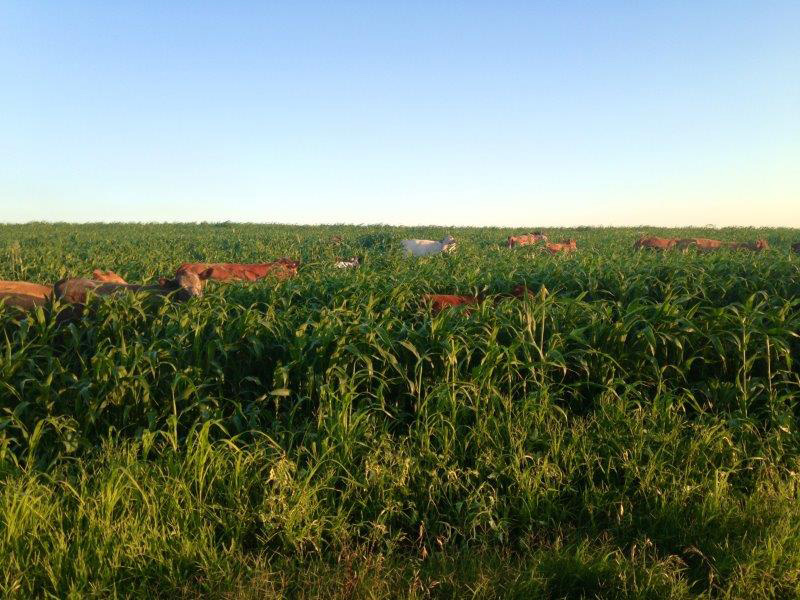
The importance of Sulphur supplementation for stock grazing forage sorghum…
Planting a cereal crop is a considerable investment in time and money so to ensure a return on investment, it is important that stock graze the forage in its entirety and without suffering from metabolic issues. Providing extra sulphur when livestock are grazing forage sorghum can help the animal to handle the prussic acid and eat more stalk and stem of the plant, therefore increasing intake and allowing the animal to better utilise the standing crop, which can be reflected in a significant increase in weight gain.
As discussed earlier, one of the key functions of sulphur is as a detoxifier to support the elimination of prussic acid. Prussic acid is not always fatal. More commonly it is present at low levels, limiting fodder intake and resulting in lower weight gains for cattle grazing forage and other sorghum varieties. Forage sorghum is also known to be quite low in both salt and sulphur and the provision of both these crucial minerals gives the animal the tools it needs to have a production response. A trial conducted by the NSW DPI and CSIRO (1978) into the Response to Salt and Sulphur for cattle grazing Sorghum, found an increase in daily weight gain in the cattle supplemented with sulphur and salt compared to the unsupplemented animals.
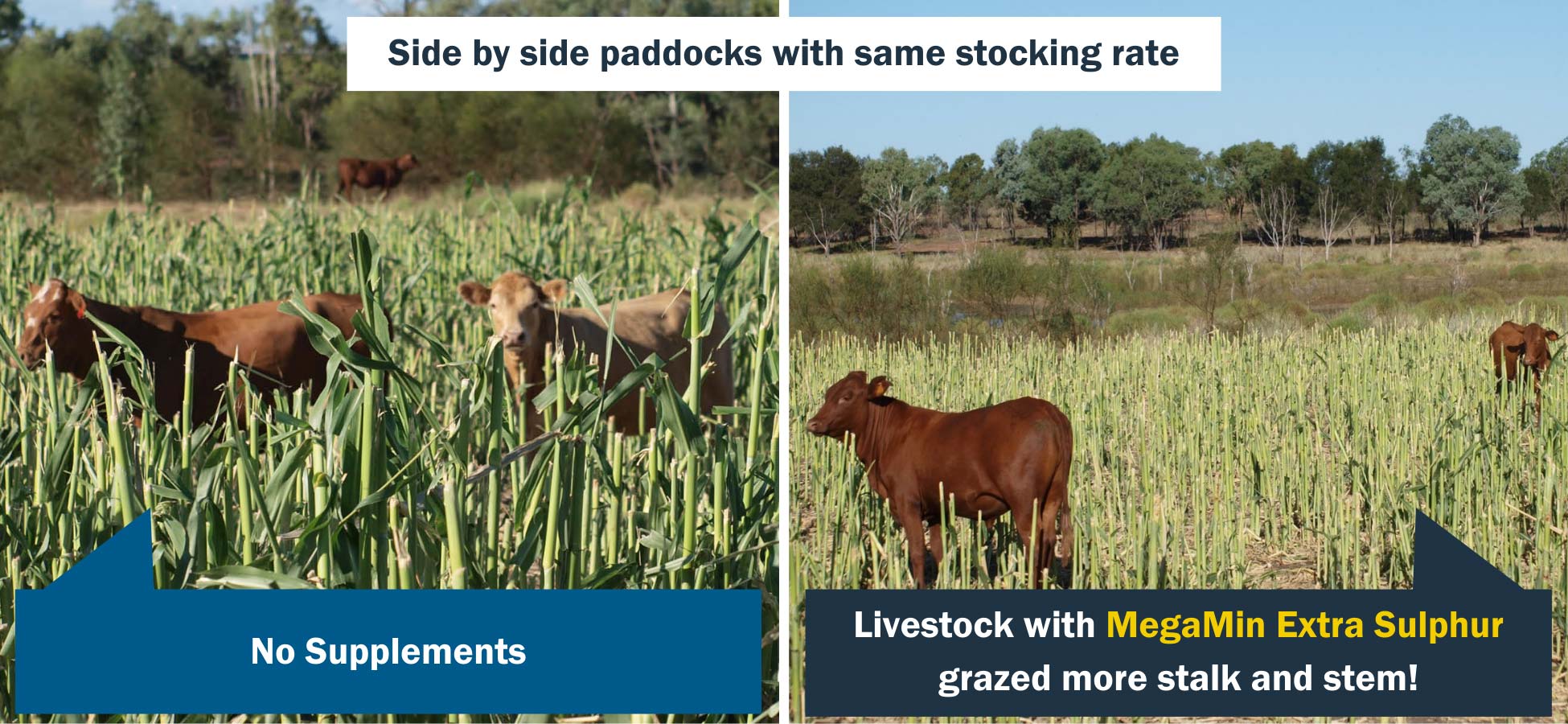
The cost of Parasites on Production and Profitability
Cattle ticks and buffalo fly thrive in hot, humid environments and as the weather warms up and the rainy season starts, much of Australia’s cattle population are driven crazy by these annoying and sometimes dangerous pests that can greatly impact on profitability.
Cattle tick and buffalo fly can both adversely affect productivity by causing a reduction in weight gain due to the discomfort the animal experiences. Also, both pests can cause damage to the hide, further impacting income. Severe infestations pose a significant animal welfare issue and a report from the MLA (2015) highlighted that cattle tick and posed the first, and buffalo fly posed the third highest cost to cattle production in Australia.
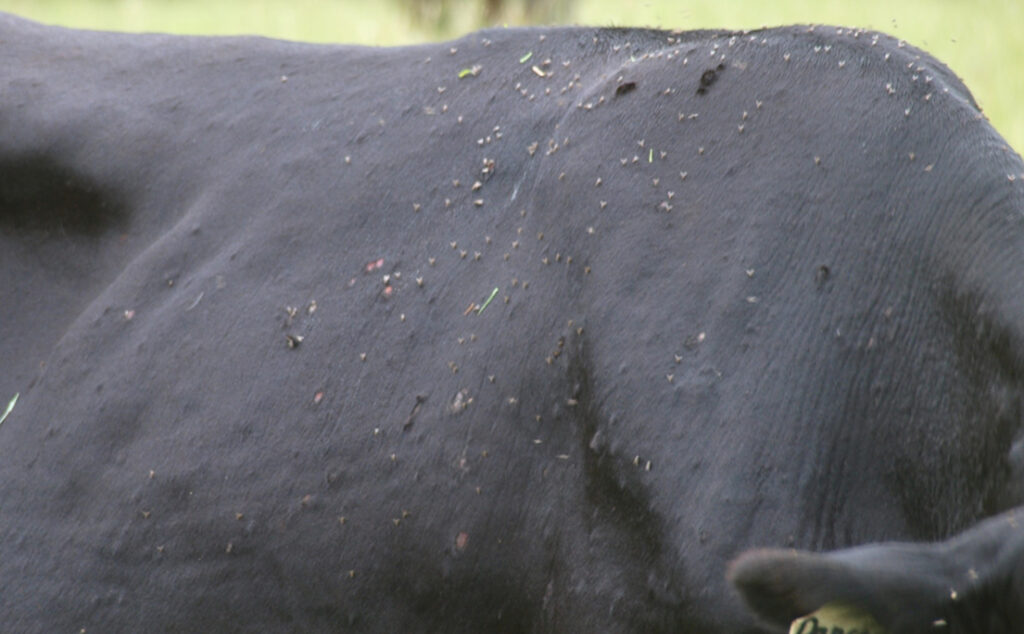
The cost of tick and buffalo fly treatment and prevention, as well as their impact on livestock production has a huge impact on profitability. The graph below shows the estimated annual economic cost of priority diseases of cattle.
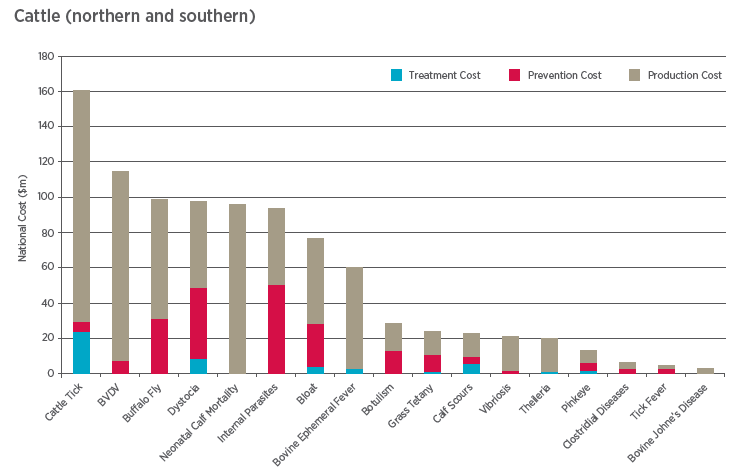
Sulphur assists to reduce parasites
Over the years, there have been many anecdotal claims about the benefits of using sulphur supplementation to assist in the control of external parasites such as cattle tick, lice and buffalo fly. Scientific research from South America has proven that sulphur can increase stock resistance to cattle ticks. In these trials, there was a substantial increase in the level of natural resistance to ticks for cattle fed additional sulphur. Villar (2006).
If using supplemental sulphur can assist in reducing the parasite burden in livestock, it will have a follow on effect as calm and content livestock area easier to handle, will graze more and in turn gain more weight and consequently helping profit margins.
These photographs, taken on a property west of Condamine, shows the difference in fly level between two animals that have been separated by an electric fence, with one having access to MegaMin Extra Sulphur for three weeks and the other had no access to supplement.
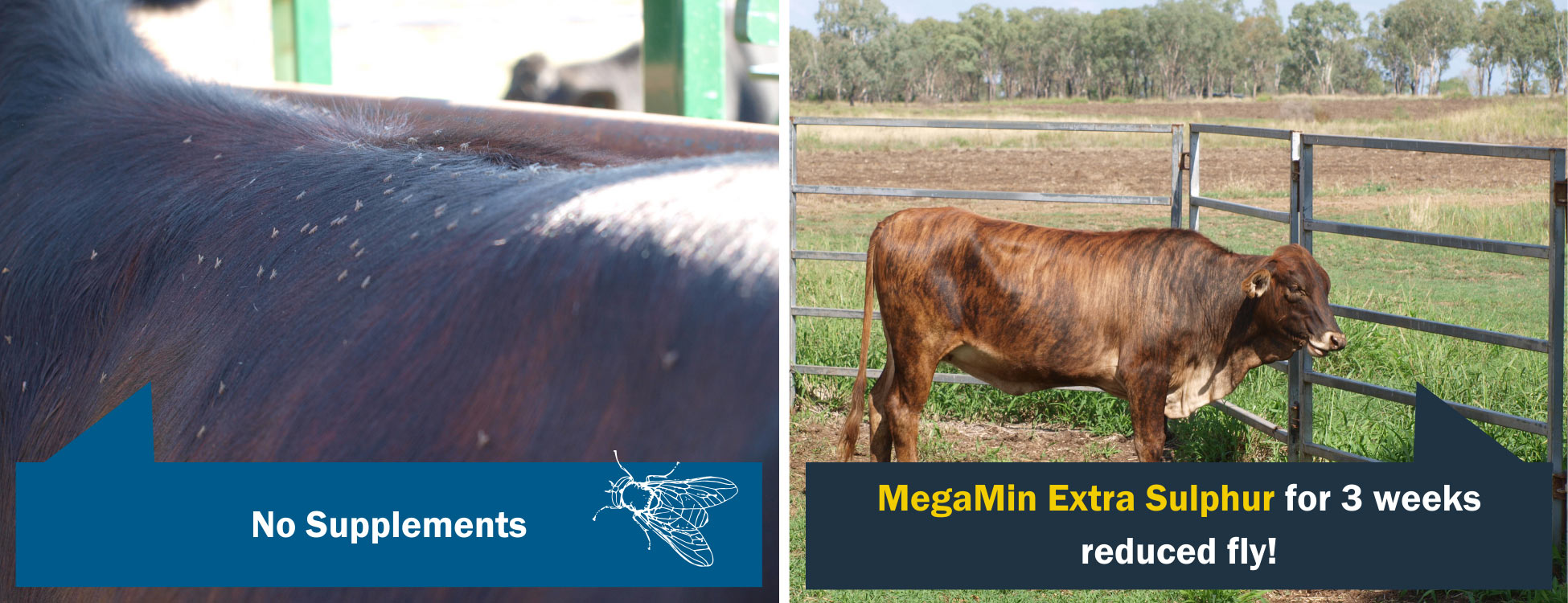
Why choose MegaMin Extra Sulphur?
Feeding straight sulphur or adding it to a feed ration yourself, comes with an element of risk. Excessive consumption can result in sulphur toxicity and secondary conditions like Polioencephalomalacia (PEM). Symptoms of PEM can include blindness, brain irritation and death.
MegaMin Extra Sulphur has been professionally formulated to provide the additional sulphur required along with phosphorus, magnesium and broad spectrum minerals that are essential for stock health. For further information, please contact AgSolutions on 1800 81 57 57.
